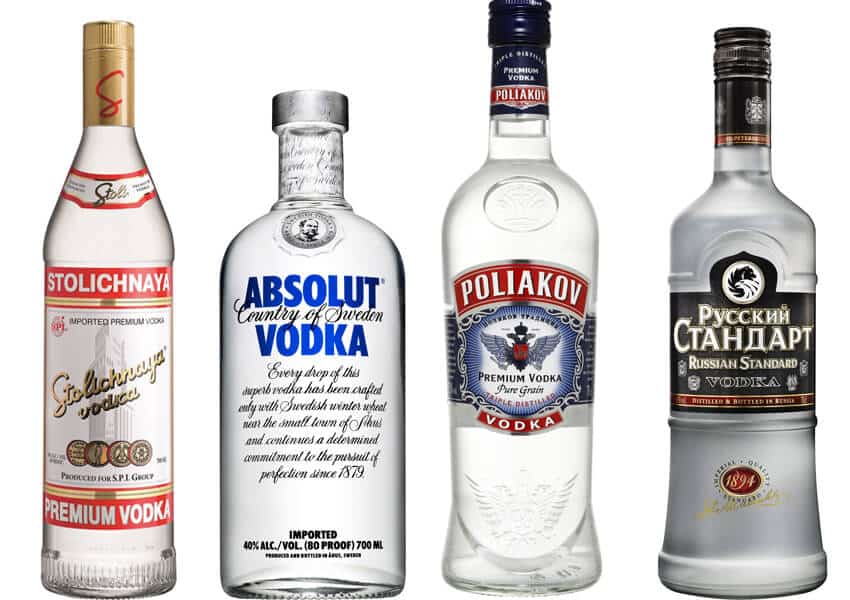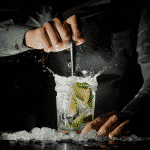
I bet that you take one look at the different ranges of vodka and if it isn’t a flavoured one, you might be thinking that they are all ‘basically’ the same.
First of all, you can’t be blamed for thinking like this. Secondly, you wouldn’t be the best that you can be unless you learn to break a few myths on what you think that you already know. That’s how you become a better bartender
So next time you are behind the stick and get questioned on vodka. You will have the ammo to fire away from the doubters of vodka, even if you started this post as one of those doubters.
We have delved into the subtle, and sometimes not so subtle, differences between vodka. Backed it up with the facts so that you have the correct knowledge to wow customers and other bartenders alike.
So let’s take a look together at the different styles of vodka that are available. Then we will delve into different vodkas with character. Which include aged vodka’s, western-style vodka and finally flavoured vodka.
GRAB THE INFOGRAPHIC HERE
THE DIFFERENT STYLES OF VODKA
Today it is wrong to think that all vodka tastes the same or that it tastes of nothing at all.
Many vodkas remain neutral in taste to provide the ideal base for mixed drinks. But, some will deliver tastes and aromas beyond the taste of the alcohol itself.
some Vodkas will deliver tastes and aromas beyond the taste of the alcohol itself. Click To Tweet
The ‘best’ of these spirits will rightly pride themselves on their purity.
Unlike other spirits, with vodka, there are no industry standards that can imply quality through letters or marks on the label. Instead, vodka brand names offer the promise of consistency through the processes and raw materials used to create the vodka.
Country of origin, if stated, can suggest the use of certain raw materials and production processes. But more on that later.
Now in recent times there has been increasing references to the use of specific raw materials regardless of country of origin. This provides more guidance about the likely character of the vodka. Much will then depend upon the filtration process and the subtleties that it provides.

IDENTIFYING VODKAS WITH CHARACTER
These will include Eastern rye, wheat and potato vodkas. That, thanks to modern distillation techniques, are now pure and clean, unlike their ancestors. These vodkas will always keep some of the characters of their raw material though. As they have been distilled to relatively low levels of alcohol.
These will include vodkas rooted in the East, like in Poland. A country on the spice trade route from Asia to Europe and will use exotic herbs and spices. Or local materials such as the fragrant bison grass or wild bees’ honey. Examples of this are Zubrowka and Krupnik.
Initially, such ingredients were used to mask the unpalatable raw alcohol and to help the ‘medicine’ go down.
But, as the aristocracy in both Russia and Poland took greater responsibility for distillation. Flavours and aromas were added to enhance and individualise the vodkas to set them apart from others.
These traditions are strong. The flavours result from lengthy processes such as infusion, maceration or leaching.

Today such vodkas can be enjoyed for their individuality whether mixed or taken neat.
These are not to be confused with some of today’s flavoured vodkas that are the result of cold compounding.
There is also an increasing number of Western vodkas, keen to be differentiated from neutral vodkas. They differentiate themselves by claiming that the process of distillation, or the character of the vodka. Is retained from single or multiple grains, potatoes or fruit that carries through into the finished spirit. Either in terms of taste or texture or both.
AGED VODKA
This is a tradition noted particularly in Poland, where the vodka may be laid down in empty wine casks at the birth of a daughter. Then the vodka is to be enjoyed on her wedding day.
These are aged in oak barrels in much the same way that whisky is. Even the big vodka companies such as Absolut Vodka have created their own oak barrel-aged vodkas available for sale.
WESTERN STYLE/NEUTRAL VODKA
Initially all, and still most Western vodkas are rectified spirits. These are usually distilled from grain or molasses and filtered.
The more expensive vodkas are filtered through tons of charcoal. They are then reduced with pure demineralised water and bottled, ready to drink, with no maturation.
They are to be judged on their purity and cleanliness alone. They are simply pure alcohol and water. They are style not substance, packaging not content. This may be the keys to the success of most with most companies claiming that their exceptional purity is why they are so successful.
This style of vodka arrived in the West thanks to Rudolph Kunett. Whose family, before the Russian Revolution, had supplied grain to the Smirnov family.

He met Vladimir Smirnov in Paris after both had fled the Bolsheviks. It was there it was agreed he would take the recipe for Smirnoff to the States (Vladimir had changed his surname from Smirnov to Smirnoff).
Wait… What are the Bolsheviks?
Below quote taken from here
In 1917, two revolutions swept through Russia, ending centuries of imperial rule and setting in motion political and social changes that would lead to the formation of the Soviet Union. In March, growing civil unrest, coupled with chronic food shortages, erupted into open revolt, forcing the abdication of Nicholas II (1868-1918), the last Russian czar. Just months later, the newly installed provisional government was itself overthrown by the more radical Bolsheviks, led by Vladimir Lenin (1870-1924).
In short, Vladimir was rich and needed to get out of Russia before Communism took over.
It was in America in 1934, post- Prohibition, that Vladimir setup the West’s first vodka distillery. But he was ahead of his time and it was not until a marketing man, called John Martin, acquired the rights to Smirnoff in 1946. He then launched Smirnoff, as a pure, neutral spirit to mix with anything.
It was at that point that the West woke up to vodka.
The Moscow Mule was the first of many cocktails to encourage sampling of this tasteless, odourless spirit (in the western style).

In the 50+ years since vodka has grown to become the world’s most popular spirit. The appeal of most Western vodkas remains their lack of aroma beyond the pure smell of ethyl alcohol. A taste that’s light and crisp without heavy flavours or oily texture, that won’t overwhelm any liquid added as a mixer.
See a bigger look at the history of vodka here
FLAVOURED VODKA
Flavoured vodka is defined as having been given a predominant flavour other than that of the raw materials.
It may be sweetened, blended, flavoured, matured or coloured. Though many are brand extensions of vodkas that have appeared relatively recently.
It is certain that the original vodkas would have been flavoured to mask the raw nature of the alcohol. Today flavourings, however, may be cold compounded extracts. Natural ingredients have been macerated in alcohol and/or water. The result of percolation or flavoured distillates blended in before bottling.
CONSUMPTION
In Russia vodka is traditionally drunk chilled or frozen and downed in one.
The Russians were known to shoot rather than sip partly because of a belief that the fumes and not the liquid caused drunkenness.
The world of alcohol is full of amazing facts, we wrote an article on some of the best ones here
In Poland however, vodka is usually sipped, with food and at room temperature to allow the tastes and aromas to be enjoyed.
In the West, vodka has gained its popularity mixed with fruit juices or in cocktails. But today, knowing more about what’s in the bottle and the production processes. In fact today regional variations, heritage and traditions are as important to the enjoyment of vodka as any other spirits.

Conclusion
So next time you are faced with the question of vodka, you should be able to ask what style of vodka the customer wants. And also give them a little background on what they are about to drink
This is just the first in two parts of Vodka take a look at;
go read the second part now
Hit me up in the comments if you want to know more
You can still grab your free download below also
GRAB THE INFOGRAPHIC HERE
Key Takeaways:
Vodka companies are now fighting to be the purest of the pure in both processing and raw ingredients.
Different raw materials can be used to produce vodka, you can normally tell which raw material has been used by the country of origin.
Though the raw material used to produce the vodka is important to the character created, so is the nature of filtration.













Nate
The legal regulatory definition of vodka is “a neutral spirit so distilled, or so treated after distillation with charcoal or other materials, as to be without distinctive character, aroma, taste, or color.” You can’t sell Vodka in the US if there is any way to tell the difference. You used a couple thousand words to say “i totally am
susceptible to marketing”.
monkfelonious
Who could possibly care other than this guy. After the first, your palate won’t know or care. I dare anyone to challenge Kirkland’s after two fingers. This vodka snobbery is just stupid.
Joel Mitchell
A lot of people do care, One person’s snobbery is someone else’s passion
Priyanshu
todd… yeah, and it’s also very “cool”!!!cat… so far so good. haven’t dont much lately tho’ beacuse of the intestinal virus outbreak (enterovirus), plu olivia has really sensitive skin so the heat gives her rashes. unfortunately, didn’t go to canada day. really wanted to tho’. as a matter of fact, i went to the russian pub during last year’s canada day beach party.boyd… would be cool to see some photos from the 80’s!